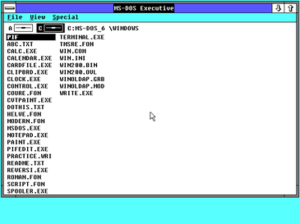Windows 2
Windows 2.0 is a 16-bit Microsoft Windows GUI-based operating environment that was released on December 9, 1987, and is the successor to Windows 1.0.Windows 2.0 allowed application windows to overlap each other, unlike its predecessor Windows 1.0, which could display only tiled windows. Windows 2.0 also introduced more sophisticated keyboard-shortcuts and the terminology of “Minimize” and “Maximize”, as opposed to “Iconize” and “Zoom” in Windows 1.0.
The basic window setup introduced here would last through Windows 3.1. Like Windows 1.x, Windows 2.x applications cannot be run on Windows 3.1 or up without modifications since they were not designed for protected mode. Windows 2.0 was also the first Windows version to integrate the control panel. New features in Windows 2.0 included VGA graphics (although in 16 colors only).
It was also the last version of Windows that did not require a hard disk. With the improved speed, reliability and usability, computers now started becoming a part of daily life for some workers. Desktop icons and use of keyboard shortcuts helped to speed up the work.The Windows 2.x EGA, VGA, and Tandy drivers notably provided a workaround in Windows 3.0 for users who wanted color graphics on 8086 machines (a feature that version normally did not support). EMS memory support also appeared for the first time.IBM licensed Windows’s GUI for OS/2 as Presentation Manager, and the two companies stated that it and Windows 2.0 would be almost identical.
Key features of future versions of Windows that were built on Windows 2
Future versions of Windows built on the foundation laid by Windows 2 and introduced several key features that are still in use today. Here are a few examples:
- Windows 3.0: Released in 1990, Windows 3.0 was a major upgrade that introduced several important features, such as virtual memory support, improved performance, and the ability to run in protected mode. It also included several popular applications, such as the File Manager and Program Manager.
- Windows 95: Released in 1995, Windows 95 was a major milestone for Windows and introduced several key features, such as the Start menu, taskbar, and long filenames. It also included support for Plug and Play devices, which made it easier to install and configure hardware.
- Windows XP: Released in 2001, Windows XP was a significant upgrade that introduced several new features, such as the Windows Security Center, Remote Desktop support, and the Windows Media Player. It was also the first version of Windows to use the NT kernel, which improved stability and security.
- Windows 10: Released in 2015, Windows 10 is the latest version of Windows and includes several new features, such as the virtual assistant Cortana, the Edge web browser, and the ability to run Universal Windows Platform (UWP) apps. It also includes several security and privacy enhancements, such as Windows Hello and the Windows Defender Security Center.
Overall, these future versions of Windows built on the foundation laid by Windows 2 and introduced new features and enhancements that have helped to make Windows the dominant operating system in the PC market.
So, that’s all in this blog. I will meet you soon with next stuff .Have a nice day !!!
Recommended contents
RODC Installation Guide- Step by step guide to install read only domain controller
RODC Filtered Attribute Set
Installing and configuring a RODC in Windows Server-2012
How to find the GUID of Domain Controller
Understanding Group Policy Preferences
Group Policy Verification Tool GPOTool Exe
Group Policy Health Check on Specific Domain Controller
What is Netlogon Folder in Active Directory
Create Custom Attributes in Active Directory
Check the Tombstone Lifetime of My Active Directory Forest
Determine a Computers AD Site From the Command Line
Check the Active Directory Database Integrity
Check the Active Directory Database Integrity
Disabling and Enabling the Outbound Replication
DFS Replication Service Stopped Replication
What is Strict Replication Consistency
The replication operation failed because of a schema mismatch between the servers involved
Troubleshooting ad replication error 8418 the replication operation failed because of a schema mismatch between the servers
How to export replication information in txt file
Repadmin Replsummary
Enabling the outbound replication
Guys please don’t forget to like and share the post.Also join our WindowsTechno Community and where you can post your queries/doubts and our experts will address them .
You can also share the feedback on below windows techno email id.
If you have any questions feel free to contact us on admin@windowstechno.com also follow us on facebook@windowstechno to get updates about new blog posts.

